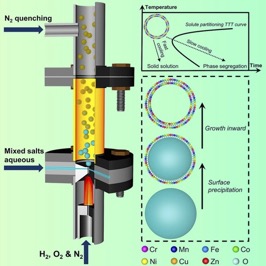Scientific Achievement

Development of a novel flame aerosol process for fabricating compositionally and structurally diverse high-entropy nanoceramics in a scalable, one- step method.
Significance and Impact
Our new method can produce both stable and metastable high-entropy materials with diverse crystal structures, including a record- breaking 22-cation-element fluorite phase. Having unprecedented control in high-entropy design allows for their application in emerging areas, such as catalysis.
Research Details
- The process provides synthetic access to a wide variety of materials impossible to access using traditional solution- and gas-phase methods limited by equilibrium miscibility and doping rules.
- Simple aqueous precursors and facile scalability hold promise for this work to translate well to industrial adoption in catalysis, etc.
Liu, S., Pao, C-W, Chen, J-L, Li, S., Xuan, Z., Song, C., Urban, J.J., Swihart, M.T., Dun, C. Matter 7. 1-20. (2024) DOI:10.1016/j.matt.2024.07.019
Research Summary
High-entropy ceramic oxides feature five or more cations randomly distributed among identical sites in a single crystal phase. They have shown great promise in energy-related applications, such as catalysis, energy storage, and thermal management, by vastly expanding the space of accessible material compositions and resulting properties. However, current synthesis methods are energy intensive, costly, and limited to thermodynamically stable structures.
The research team of Foundry staff and users developed a versatile and scalable flame aerosol method that can produce both stable and metastable high-entropy materials with diverse crystal structures, including a record-breaking 22-cation-element fluorite phase. In a representative application, a Pt-(MgCoNiCuZn)O high-entropy single-atom catalyst showed superior activity and long-term stability, maintaining constant CO2 conversion over 670 h and dramatically outperforming conventional catalysts.
The laboratory-scale method reported here has a clear path to industrial-scale implementation and thus toward establishing high-entropy oxides as commercially viable materials. Investment in scale-up for a specific application will be essential to broader impact.

